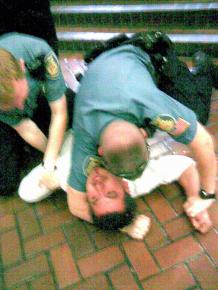Why did police attack Julio Hernandez?
reports on an incident of police brutality at Seattle Central Community College--and the protests against it.
SEATTLE CENTRAL Community College (SCCC) student Julio Hernandez was beaten by two Seattle police and three campus security guards during class changes on May 28, in front of a crowd of at least 100 people.
The school administration has invoked Virginia Tech in defending its decision to involve the police, who claim to have exerted just enough force to subdue a violent student attempting escape.
But from the very beginning, the administration and police have been forced to contend with a student response, the reports of many witnesses disputing the official story, and their own contradictory accounts.
Jorge Torres watched the event unfold. "I was right in front of the steps, and noticed two cops, and one or two security guards approach [Julio] and circle him," Torres said. "One of the cops reached to frisk him, and he jumped back in surprise. [Julio] didn't do anything, and they kept talking. A few minutes later, one of the cops grabbed him by the throat and pushed him to the ground. He continued to choke him, and [Julio] struggled under him."

A crowd quickly gathered, and the initially stunned students began to shout at the police. Cries of "Let him go!" were ignored by the police, as they threw their fists, elbows and knees into the student.
"The other cop jumped on top, and the three wrestled and wound up rolling down the stairs," said Torres. "One of the cops actually leaned the kid over, and the other one kneed him in the head. After that, they pushed him to the ground, and a third security guard rushed up. At this point, they had Julio's hands behind his back."
In the melee, a gun came loose, clattering to the ground and sending several bullets skittering. One cop turned his attention from Julio, whose face was pressed into the ground, to grab the gun. He elbowed and shoved a student to get at a bullet, and returned to reload the gun in front of Julio's face.
Several in the crowd began to shout in terror, others in disgust, "Why do the police have a gun out in school?" The policeman holding the gun claimed it belonged to Hernandez and then helped drag the student outside. They were met by 20 or 30 more police, and a dozen police cars with lights blazing.
Julio was taken away, while others, confused, angry and scared, milled outside the building and waited for some word as to what was going on.
SCHOOL ACTIVISTS immediately began organizing a response. One student began collecting statements from those who had seen the incident unfold. Another spoke with the media, and others discussed their response.
Within a few hours, a speakout was organized for the following day's Unity Fair, an end-of-year event held by the college. Five or six media outlets covered the speakout. "The students and the progressive community on campus must demand that the cops be held accountable for their violence and endangerment of the student body, " Darrin Hoop told the crowd.
Between the time of the arrest and the eventual release of a statement from the school administration, several versions were circulated about what Julio's crime had supposedly been.
The rumor quickly spread around campus that he had been carrying a gun, but many had noticed that the fallen gun was re-holstered by an officer--several students had actually caught this on their camera phones. While the police were eventually forced to issue a retraction, many had already been confused by the lie and assumed the police had apprehended a genuinely dangerous person.
Students were told at various times that Hernandez had sexually harassed a woman, threatened a professor and either directly threatened two students or was overheard making threats. It was revealed that the threats were made the previous Friday, reported on Tuesday after the holiday weekend, and dealt with the next day, when the student was scheduled to be in school.
The school administration has refused to discuss the details of the alleged threats. Nor did it give much explanation for why a "serious threat of mass violence" did not result in police being dispatched to the student's home to deal with the issue previously, why no students received an e-mail warning, or why the school wasn't closed for the day.
Julio Hernandez's case is not an isolated one. It's not even the only recent incident of police brutality in Seattle. According to a Seattle Post-Intelligencer report, there have been at least 161 force cases at the Seattle Police Department in the past 18 months. No officers have been disciplined, despite the city losing cases in which it paid out $47,500 in response to a 2003 march against police brutality and $1 million to WTO protesters.
Less than a month ago, a judge threw out the city's case of resisting arrest against an antiwar protester, after seeing video footage of the brutality he endured. The same sort of video evidence exists for Hernandez, for whom a trial cannot come too soon.
A week after his arrest, Julio sits in jail on $75,000 bail. Incredibly, he will be tried for three charges of assault, disarming a law enforcement officer and malicious harassment, a charge reserved for those who burn crosses or paint swastikas.
The swift, organized and uncompromising stand made by other students has put Hernandez in a position to win justice. Their support has sent the message that police brutality will be challenged and exposed.


